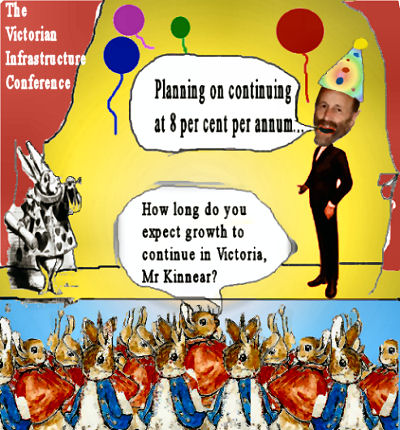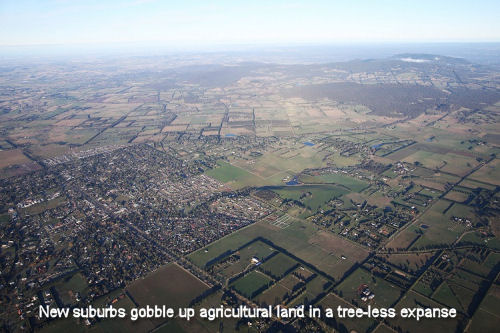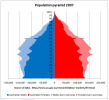
Report on the Victorian Transport Infrastructure Conference
11-12th May 2009 @ the Melbourne Convention Exhibition Centre
by Catherine Manning
President, Southern Victoria Community Action Group Inc.
 Foreword: A huge thank you to all of the groups and individuals who contributed to the cost of a ticket so that our community could be represented at this conference. As expected, the conference failed to provide any new information about the implementation of the Victorian Transport Plan (VTP) and seemed to have left some who'd paid up to $1655- for a ticket deeply disappointed. (One participant told me he was so stressed about what he was going to report back to his boss, as he'd convinced him it was worth spending the money to go and 'do business'.) However, I believe it was well worth SVCAG being there, as I was able to publicly question several ministers and bureaucrats on behalf of all of our groups, and made it known that we were concerned at the 'exclusivity' of the event that was publicised as a 'high level forum for discussion and debate'. To download a copy of / or view the VTP please go to www.transport.vic.gov.au
Foreword: A huge thank you to all of the groups and individuals who contributed to the cost of a ticket so that our community could be represented at this conference. As expected, the conference failed to provide any new information about the implementation of the Victorian Transport Plan (VTP) and seemed to have left some who'd paid up to $1655- for a ticket deeply disappointed. (One participant told me he was so stressed about what he was going to report back to his boss, as he'd convinced him it was worth spending the money to go and 'do business'.) However, I believe it was well worth SVCAG being there, as I was able to publicly question several ministers and bureaucrats on behalf of all of our groups, and made it known that we were concerned at the 'exclusivity' of the event that was publicised as a 'high level forum for discussion and debate'. To download a copy of / or view the VTP please go to www.transport.vic.gov.au
Disclaimer: I have compiled this report from my notes taken at the conference. I cannot guarantee the accuracy of the information, only to say this is purely an honest account of how I saw the event, but others may have seen it differently. I have tried to dot point as much as I can, and have added some questions that I asked (and some I didn’t !).
Day1
 MC: Rob Gell opened the event .
MC: Rob Gell opened the event .
Rob Gell thanked the sponsors/supporters: Project Link, Theiss, DLA Phillips Fox, Vibropile, Brifen, Coffey Rail, Leighton, Dial Before You Dig, GTA Consultants, Engineers Australia, and of course the State Govt - Dept. of Transport.
9am
 Jim Betts - Secretary, Department of Transport Victoria
Jim Betts - Secretary, Department of Transport Victoria
After explaining his disappointment at his title of ‘secretary' which made it sound as though he should just be ‘taking minutes’, Jim convinced us that he is really a very important person. He then proceeded to give a quick explanation of the VTP...
• Melbourne @ 5million and the Victorian Transport Plan were produced together and will be updated every 3-4 years to adjust figures ie. population growth, etc.
• would like to work with industry to spread the freight task
• Into the future 2030 - more freight 'immune to economic issues’
• Vision for a 24hr operation, mass transit orbital system, significant expansion in port rail as per Eddington Report.
• 'We're planning for Hastings at the moment'
• Mentioned the 'Freight Futures' document (more on that later)
• Channel Deepening (plug for)
It was then opened up to the floor for questions. Rob Gell asked about four questions on interstate rail, emissions reduction and fuel efficiency.
(I didn’t hear a substantial answer, other than 'we're working on it' or words to that effect.)
 Tim Holding as Minister for Finance, Victoria
Tim Holding as Minister for Finance, Victoria
• restated that the State Budget saw an $8b investment in 09/10 infrastructure for transport, schools, etc..
• Victoria the best place in the country, best workers... Wants to be the 'best placed in the country' - jobs jobs jobs... in transport - freight & logistics.
• VTP is the plan, the vision, the context to tell the community where to go with infrastructure projects...
• Sustainability is at the heart of this plan…sustainability…sustainability..
• mentioned Peninsula Link, Epping Line (rail upgrade), Lynbrook (road)
Question Time:
Catherine Manning Southern Victorian Community Action Group (SVCAG): Minister, I notice you say 'sustainable and sustainability' a lot, what is your definition of sustainable when it comes to this Transport Plan? How can more and more growth, less local manufacturing, a massive increase in freight imports, more port development i.e. Hastings, and the associated truck movements, be anything but unsustainable?
Tim Holding: ‘freight needs the best possible infrastructure to be sustainable’, etc., etc. Said something to the effect that now we all expect higher quality living, we have to develop Hastings so we can provide it. (Incredibly, he then went on for another ten minutes without answering my question….)
 Halvard Dalheim - Director, State Strategy, Planning Policy Branch
Halvard Dalheim - Director, State Strategy, Planning Policy Branch
1. Green Spaces. Spoke about Melb @5million, 1.8 additional people by 2036. 600,000 dwellings in the next 20 years. How are we placed to deal with growth? Govt response was to release its 'transport policies'.
2. Challenges - Shaping Victoria, linking regional Victoria, Sustainable Growth, unblocking congestion, responding to climate change.
3. Unique Collaboration - benefits/new approaches/relationships/new opportunities - VicRoads/DOI (now DOT)/DSE. Urban Growth Boundaries - new issues raised and discussed...loves collaboration...(group hug with DSE/VicRoads/DOT)
4. Managing Melbourne's Growth
5. Scale of Growth .. (up, up and up..). How do we accommodate this growth?
 6. Components of Growth - international migration levels never seen before...address future labour force. Long term drivers - migration. Health infrastructure needed - maternity wards.
6. Components of Growth - international migration levels never seen before...address future labour force. Long term drivers - migration. Health infrastructure needed - maternity wards.
7. Trends of Growth Maps - bridge the Yarra/Maribyrnong
8. Affordability and Growth - affordable living, housing, etc.
9. Shaping Melbourne's Growth - The growth equation: 316,000 established areas. 284,000 growth areas. 134,000 new growth areas. Shift new growth areas North and West. Expand growth areas and high density living in Melbourne.
10. Urban Form and Growth. Block sizes.
11. Accessible Jobs. Can't keep building roads and tunnels to handle our transport issues. So now we have 'land use and transport planning' so we can influence potential behavior patterns.
12. Disadvantaged with Jobs
13. Mode of Travel and Jobs - cars cars cars.
14. Proximity of Jobs
15. A Sustainable City Form. 'Polycentric' Multiple major centres - jobs close to home. Box Hill, Broadmeadows,Dandenong, Footscray, Frankston, Ringwood.
16. Inner Core - housing.
17. Tram Network
18. Conversions - housing
19. New Opportunities
20. Infill - across metro area
21. Residential Initiatives - lot densities. 'Local intelligence' looking at City of Moreland.
22. Melbourne's Newest Sustainable Communities - rail links, smartbus, Northern Suburbs.
23. Delivery - 'Transport plan.....shaping Victoria....jobs...jobs...jobs.'
 Ray Kinnear - Dep Director Strategic Policy and Planning, Public Transport Division
Ray Kinnear - Dep Director Strategic Policy and Planning, Public Transport Division
• Growth rate exceeding current growth forecasts across all models
• More people on public transport: Why?Fuel costs, Global Financial Crisis, 20% environmental concerns
• Operating railway - creating a metro
• Local Bus Networks
• Offer early bird schemes to encourage travel before peak.
• Rail infrastructure projects underway...New track Laverton, Clifton Hill Rail Project..etc...$18b over next 2 years
• $10b sought from Building Aust Fund
• Regional Rail Link - Western part of Melb - sharing tracks/bottlenecks. Build new line west of Werribee on Geelong Line. Able to run v-line trains - no longer on suburban line.
• Build a second tunnel- Dynon area across to Parkville-Domain.
• South East capacity problem. Metro tunnel to Caulfield - all lines independent.
• Waiting for Govt Funding
• 70 new trains 50 new trams, maintenance facilities, light rail, more stops.
Question from Cameron of Coffee Projects: How long do you anticipate that growth to continue?
Answer from Ray Kinnear: planning on continuing at 8%p.a.
Jonathon Metcalfe - Exec Chair Connex
• challenging times
• Pollution 'we've talked about that'
• PPP's - more from the VTP about what's being delivered....
• more PR pitch about keeping customers happy and 'managing dissatisfaction'.
Question: What about level crossings?
Answer from JM: Where there's a business case.
(mass exodus - about 15 people left the auditorium at this point)....
Question unposed: When you say ‘pollution – we’ve talked about that’, when exactly did we talk about it? I’ve been awake the whole time…did I miss something?
Question unposed: Shouldn’t we refer to climate change as a problem, not a ‘challenge’? I know it’s very ‘Chopra-esque’ to say ‘challenge’, but doesn’t that make it sound like a fun run or math’s quiz, not the serious environmental issue that it is? It may be challenging to find solutions, but if we’re to be really honest, wouldn’t you say that climate change is really a big ‘issue’ or ‘problem
Brad Vann - Partner, Clayton UTZ
• Cost $60b to replace all of Victoria's level crossings - how to deal with this in Global Financial Crisis?
• Impact of credit crunch - lack of liquidity - banks retreating from long tenure and complex lending
• Cost of funding PPP's - as liquidity in markets decreases, lending margins increase....
• Feast or Famine: sales pitch for PPP's - alternatives:  Govt underwrite financing bids (potential conflict of interest) - unsyndicated portions of debt taken up by govt entity until full syndication possible - shorter concession periods - shorter term financing.
Govt underwrite financing bids (potential conflict of interest) - unsyndicated portions of debt taken up by govt entity until full syndication possible - shorter concession periods - shorter term financing.
• Market disruption risk
• Govt takes back some risk - ie. Hospital infrastructure project - decrease payments from the private sector if not bringing in the $$$.
• Unbundle the project
•  Peninsula Link 'economic infrastructure' - No toll, therefore needs $$$. then Govt repay private sector. Govt looking at this way.
Peninsula Link 'economic infrastructure' - No toll, therefore needs $$$. then Govt repay private sector. Govt looking at this way.
•  Super Funds - Institutional Funds. Govt guarantee to lift the quality of the project and attract investment thru super funds etc. In turn, super and industry funds invest to keep their members in work.
Super Funds - Institutional Funds. Govt guarantee to lift the quality of the project and attract investment thru super funds etc. In turn, super and industry funds invest to keep their members in work.
•  Regulatory changes - at the moment there is better returns for people to invest overseas.
Regulatory changes - at the moment there is better returns for people to invest overseas.
•  Develop by Govt then sell to private sector [Comment by editor: This is privatization in advance]
Develop by Govt then sell to private sector [Comment by editor: This is privatization in advance]
• Ask Industry Fund Managers, if we meet operational parameters of the project, will you agree to support it?
At this point just before lunch, the MD of Theiss got up and said 'we need accelerated spend up on transport infrastructure'. However, I didn’t notice anyone jump up and wave their wallet around.
Lunch: Met a few of interesting people. Am beginning to think I'm not going so mad after all. Some of these people do seem to get it too, and aren't as excited about all aspects of the VTP as I thought they would be.... Almost managed to attract a few new members (LOL).
Panel ‘Discussion’
Darren Bilsborough – Director of Sustainability, Parsons Brinckerhoff
Rob Turk – Associate, ARUP
Sean Murphy – GM Infrastructure & Environment, Worley Parsons
Glenn Hedges – Environmental Manager/Project Services, Thiess
Refreshingly, Darren Bilsborough spoke of the ‘elephant in the room – climate change’
• the VTP failed to adequately address climate change, health impacts, peak oil or our aging population.
Rob Turk
• minimising environmental impacts by collecting run off from freeways (used Frankston Bypass as an example) to provide solutions to other issues ie. Water.
• offset planting, ‘integrated resource management’, using road corridors as IT corridors (i.e. Broadband network infr.) and ‘smart energy zones’.
• the formation of the ‘Australian Green Infrastructure Council’, formed in 2007 by various industry reps, applying for state govt funding to try to create a ‘green star’ national rating scheme for business/developers.
Lots of talk about ‘fast tracking’
• geopolymer concrete / fly ash – being used as a better alternative to concrete. 80% less emissions.
• Waste vegetable matter for ‘sandwich panels’ – reinforced skins.
• Glass work – discharge from desalination plants to replace timbers, beams, concrete, etc.
Glenn Hedges repeated much of what had already been said, plus
• A ‘promo’ for Theiss providing indigenous communities with training & jobs to build a construction workforce
• More about the Green Inf. Council and Theiss’ efforts to replace lightweight truck bodies instead of stainless steel. Auto timing switches on mobile lighting banks, and more use of diesel
Questions for panel:
Rob Gell asked: Why geopolymer concrete wasn’t used for the construction of citilink and eastlink when the government had been consulted extensively on its benefits?
Answer:…..don’t know.
Questions from Catherine Manning: What payoff will there be for developers fastracking development to seek endorsement from Aust Green Inf Council, and will it have any real effect?
Answer: No real effect as yet, but it will be a ‘feel good’ exercise. There will be no legally binding contracts
Question from Catherine Manning: Doesn’t this just provide a vehicle for developers to appear green without being green when there are no real ‘green’ guidelines for development (apart from what comes out of the EES – EPBC Act). Where we have Work Cover and legal guidelines for other things, why aren’t there laws for developers to abide by when it comes to environmental/health impacts, etc.?
Answer: inadequate policy.
Question unposed: Do you think the Global Financial Crisis is being used as justification to fast track development so that even less community consultation can be justified?
Dr Lewis Gomes and Peter Zahnleiter (Brisbane Roads and Tunnel Experience)
• Spoke of the project delivery (if you really want me to document this, let me know, but it was about as exciting to me as watching grass grow).
• Their airport link averaged $56million per kilometer.
Peter Bentley – CEO Connect East
We then heard yet another promotion and back patting exercise about Eastlink. $3.8b for 39klm of toll way. Heard about Mullum Mullum Valley, the untolled Ringwood and Dandenong Bypasses, 88 bridges, 17 interchanges and 2 tunnels.
• 270,000 trips during the toll free period
• 135,000 once tolls introduced.
• Community consultation…’no one can ever say there was a lack of dialogue on this project’. Local community forum settled community matters
• Thanks to EPA ‘s communication between groups, there were ‘no public appeals when Connect East got works approval for the tunnel/ventilation project.
• 60 wetlands established / 3.5million shrubs and trees planted
 Wrap up of day 1: So much of today sounded like repetitious, back patting, spin. There was nothing learned that wasn’t already in the VTP book. I got the sense by the end of the day that many of us hoped that tomorrow would provide far more substance, and we looked forward to ‘doing business’ and having that ‘high level debate’……
Wrap up of day 1: So much of today sounded like repetitious, back patting, spin. There was nothing learned that wasn’t already in the VTP book. I got the sense by the end of the day that many of us hoped that tomorrow would provide far more substance, and we looked forward to ‘doing business’ and having that ‘high level debate’……
Media presence
*I contacted the conference organisers beforehand to enquire about media access to the event. I was told there was none. However, Jason Dowling from The Age was there on the first day. On Day 2 Jillian Verhardt from Radio Port Phillip was permitted to attend (I didn’t see any other media at all).
DAY 2.
Good morning Rob.
 The Hon. Tim Pallas, Minister for Roads and Ports, Victoria, Steve Bracks Advisor 1999.
The Hon. Tim Pallas, Minister for Roads and Ports, Victoria, Steve Bracks Advisor 1999.
• The VTP will connect communities, build economies..etc…enhance livability, enhance amenity….etc…etc..
Apparently famous for his PowerPoint prowess, Mr Pallas lived up to his reputation and provided a lovely slide show….
10 Challenges facing infrastructure.
1. Congestion: $20.4b p.a. cost of congestion by 2020
($2.6b p.a. cost of congestion now)
‘Victoria is Australia’s Freight and Logistics hub’ – more talk about VTP Projects.
2. Port Capacity: 2035 - 8million containers annually.
Expand Swanston Dock – berth extensions
Webb dock for container handling
Transport plan for Hastings
Relocate market
Move Sth Dynon Rail terminal to Donnybrook
75% of channel deepening done – physical works due to be completed by
end of August.
3. Transport Linkages: Seymour Wodonga – Standard Guage Rail
4. Road Toll: duplicated roads safer than unduplicated
5. Freight Mode Share: more freight onto rail
Retain status as manufacturing state
90% of freight travels on road
Rail freight subsidies/freight access charges to encourage larger off-peak
use of port.
6. Intermodal Capacity: Container volumes not yet at a stage where rail is viable.
Until then encourage larger road transport to get freight around.
30m / 28m b-doubles and b-triples: tried and proven.
‘the public are accepting of b-doubles sharing the road’
7. Airport Capacity: Melbourne Airport Strategy
See Draft Airport Master plan 2008
8.
 Infrastructure Funding: imbalance – requirement of state to raise revenue, failure of states to deliver. Money taken from road fines/tolls etc. goes back in to building/infrastructure.
Infrastructure Funding: imbalance – requirement of state to raise revenue, failure of states to deliver. Money taken from road fines/tolls etc. goes back in to building/infrastructure.
Availability of PPP’s – i.e. Peninsula Link
9. Residential Amenity: Freight Futures
Truck action plan: new off ramps Westgate Fwy at Hyde St will remove 1.2 million trucks a year. Sunshine/Dempster/Paramount Rd – trucks will divert around Seddon using tunnels and new routes.
10. Port of Hastings: Bolte’s vision – lots of talk about ‘vision’
 Question: Jason Dowling (Age News) asked about the funding of the Peninsula Link, state gov. has allocated $350m but nothing in the Fed. Budget.
Question: Jason Dowling (Age News) asked about the funding of the Peninsula Link, state gov. has allocated $350m but nothing in the Fed. Budget.
Answer: Tim Pallas said he was confident they would receive the Fed. funding and said it was not unusual for items to be funded after any given main budget.
Question: 30mt. super B trucks, are they suitable for our roads?
Answer: Length is an issue, so they will only be trialed on certain routes, monitored by gps system to ensure they stick to nominated roads. See map.
Question: Catherine Manning – Considering all roads in the VTP lead to Hastings, is it not a bit dangerous to put all your eggs in one basket prior to any environmental assessment or EES? There are other ports around Victoria that could service our needs. What is ‘Plan B’ if Hastings proves to be an unviable location for major port development?
Answer: Tim Pallas: There is no plan B. Hastings is it. The EES just tells us what we need to watch out for, not whether or not we can do something. Minister Pallas assured the audience they would secure the necessary environmental approvals/considerations. Geelong has limitations. The EES is not a yes or no process. Hastings will happen.
Tim Pallas: There is no plan B. Hastings is it. The EES just tells us what we need to watch out for, not whether or not we can do something. Minister Pallas assured the audience they would secure the necessary environmental approvals/considerations. Geelong has limitations. The EES is not a yes or no process. Hastings will happen.
Justin Madden – Minister for Planning
 Again spoke of VTP and Melb @ 5million. Spoke about:
Again spoke of VTP and Melb @ 5million. Spoke about:
• Fast tracked approvals for infrastructure developments / collaboration
• Housing – growth growth growth….
• 325,000 will live in provincial areas by 2026
• Something about extra help for councils to measure households within their municipalities
• Online planning systems / ‘modernising’ planning and environment act
• Finally, we need to consult communities
Questions:
A man from Moonee Ponds: Why hasn’t growth been considered around Geelong etc.,…?
Answer: Again, hard to decipher, but something about ‘social issues as population reaches 3+million’, and ‘hamlets, villages and hinterland…’
Question: Jason Dowling of The Age asked if the Minister would sack his staffer after recent revelations re Brimbank Council.
Answer: No
Jason them commented cities over 3M seem to consistently present increased crime and other social problems.
Further reply from Minister, that our City is Attractive, especially housing as it is cheaper than Sydney. House and land packages here are around $60k less.
When does the population growth & infrastructure expansion come to an end?
 Q. Catherine Manning: Considering your PowerPoint showed massive growth on Melbourne’s outskirts, are you concerned about the impact of all this growth on our food bowl, particularly the Koo Wee Rup Swamp/Gippsland regions? When does the growth come to an end?
Q. Catherine Manning: Considering your PowerPoint showed massive growth on Melbourne’s outskirts, are you concerned about the impact of all this growth on our food bowl, particularly the Koo Wee Rup Swamp/Gippsland regions? When does the growth come to an end?
 A. (the following is a summary of what I understood of his lengthy response):
A. (the following is a summary of what I understood of his lengthy response):
The south/east is almost at capacity and they are planning to move more people out to the West where there are larger tracts of land to be built upon (I then asked ‘so why develop Hastings???’ to which he said ‘Minister of Ports answered that’ – oh did he??? Well, just because it was ‘Bolte’s dream’ isn’t a good enough answer to me!). He said the rezoning of the 6 areas identified on the far edges would be done so in an environmentally sensitive manner. The North and West were definitely the only places to develop. He then went on to say that he welcomed my questions and was assuming my next would be about the EES process after Minister Pallas’ comments (well, actually I was planning on letting him off the hook on that one as I thought I might be removed from the gallery if I asked another question!!!) He spoke about the EES as something the community feels contains a ‘do nothing’ option. He said they (govt.) were more sophisticated now and complexities have to be managed. However, he did mention that although it ‘sounds like a done deal’ (my words), he would still have to seek federal approvals (EPBC Act).
Terry Garwood – Exec Director, Freight Logistics and Marine, DOT, Victoria
• More talk about more people, more freight, more, more, more. Planning, building managing freight network.
• Victoria is home to most efficient element of road industry: B Doubles – larger b-doubles under consideration to be trialed on certain roads.
• Freight task to double from now to 2030 ‘efficiency/capacity/sustainability
• Private sector moves freight on shared networks: trucks/cars, air freight/passenger, recreational boating/shipping.
• Government owns ports ( the ones in the VTP)
• ‘Planning and protecting’, ‘building and maintaining’, ‘managing and regulating’….( lots of buzzwords!)
• National rail that bypasses all major cities (now you’re talkin’!)
• International terminal at fresh market
• Truck Action Plan: building the network, freight charge during the day – encourage night road use
• Port of Melbourne’s charter to change to expand its role outside the port gate, giving them more power beyond the fence line of their current site.
• New policy document: Port Futures – tweaking the PLUTS
• This document will take Hastings and the UGB’s into consideration.
• There are no plans to introduce b-triples onto our Victorian road network, just longer b-doubles.
Question: Would Rail-Share suffer with the introduction of larger trucks?
Answer: Yes. Intra rail is port related. Interstate Rail non port related. National by passes all Capitol Cities. eg. Donnybrook Terminal. Metro rail freight is currently zero.
Question: Rob Gell: were green-house gas emissions part of the over all decision making process, especially trucks?
Answer: Aviation was quoted as 1.5% emissions, shipping 1.5% emissions. (Maybe he meant shipping and Transport, but that needs to be looked at.)
Rob said if Darwin was the Sea/Container terminal, how about train to the rest of the nation?
Further A. Melb. to Sydney Rail attracts barely 5% all freight movements. Funds are likely to be directed to increase rail and they are in close contact with Fed. Gov.
Question Unposed: Have the social impacts been considered or ‘costed in’ of the hundreds and thousands of ‘Daddies’ out there encouraged to drive their trucks only at night?
 Stephen Bradford – CEO, Port of Melbourne Corporation
Stephen Bradford – CEO, Port of Melbourne Corporation
After a few figures relating to the Global Financial Crisis’s impact on freight movements, Stephen Bradford got stuck right in to the community for daring to suggest that things might not go so well to plan as expected. Here’s a rundown:
TEU’s (containers) Motor Vehicles
Dec. down 5.2% down 28.7%
Jan down 16% down 33.8%
Feb down 7.6% down 35.9%
Mar down 7.6% down 38.7%
TEU’s down 1.5% to Mar 09
Cars down 15.9% to Mar 09
Dry Bulk down 1.8% to Mar09
Long Beach down 30%
Seattle down 24%
Tacoma down 15%
Oakland down 16%
Los Angeles down 17%
(anyone wanna buy a transport plan???)
• 8 million TEU by 2035
• 60% container vessels are draught constrained, need ‘a hole in the sand’ – dredging.
• $12million EES
• Headlines cut and pasted on PowerPoint of ‘Negative Headlines’
He then went on to show news footage of ‘community reaction’, including the ‘Battle Zone’ story with Jo Hall, a Blue Wedges Rally, protesters and the exclusion zone, Federal Court story….etc..
• EES – after 130 recommendations from initial panel, rebuilt the team, performed the highest environmental studies, project liaison group, ‘subsequently we then had the SEES peer review by experts not on the original panel as selected by the state government’.
• Successfully dredged with no environmental impacts
• On schedule and within budget
• Port corporation took the option to be vigilant and open
• EMP is very rigorous
Followed by the ‘Big Tick’ video of the Queen of the Netherlands
• Took on an advertising campaign
• Showed the media ad
• More justification of media campaign
• Looking at Hastings and other ports
• By the way, loves the little penguins – lots of monitoring of the little cuties.
Question: What benefit to the environmental outcome of spending the $120M second/further EES re Bay Dredging.
Answer: He said it was worth it, they learned more about sea-grasses, penguins and turbidity. He also commented that the second 'team' convened to carry out the 'further' EES were almost an entirely new crew.
Question: CEO RACV Negus asked about increased container volumes on roads.
Answer: Negus was directed to the presentation by the previous speaker and he had answered all that. Negus only attended for the Bradford presentation and left the conference shortly after.
Question: Was Mr. Bradford concerned about increased severity of storms, King Tides etc. adding to an increase water level in the bay.
Answer: No.
Question unposed: When you say the port corporation ‘took the option’ to be vigilant and open, what was the other ‘option’?
The Hon. Jacinta Allen, Minister for Regional and Rural Development
More of what seemed like a ‘press release’ from the VTP.
Question Jillian Verhardt (Radio 3RPP): Despite a recent massive upgrade there is great congestion at times at the Tulla/Calder merge. Bendigo and towns such as Gisborne had been touted as ‘commuter satellites’ for those seeking affordable regional housing yet wishing to remain working in Metro yet get home at a reasonable hour. Asked about the Melbourne City to Tullamarine light rail in terms of alleviating serious congestion, and stated that the airport had been doubled in capacity around 5 years ago, and the management were out there last year stating another doubling would be required to keep up with increased aviation activity.
Answer: Dismissed the question as it was in her opinion a metro issue, yet the highway, Calder and Tullamarine Freeway are heavily used already. As other road issues around the freeways are ‘addressed’, it is assumed that will ease congestion.
Panel ‘Discussion’
Tim Ryan – GM, ARTC
Helen Newell – Director, Corporate Dev. & Government Relations, Asciano
Andy McNicol – Coffee Rail
Tim Ryan
• Nth/Sth rail corridor: Melb/Bris/Syd – 16m gross tonnes to 28/35m 2015
• East/West: Melb/Syd/Perth – 80% market share - focus to sustain operation – not much growth in it.
• Include customers, deliver what the market wants, location of terminals to take long trains, commercial opportunities in regional areas.
• Trucks have access to good road networks, makes it difficult to compete for $$$ for rail infrastructure.
• 1.8klm trains Syd/WA 1.5klm trains Bris
Helen Newell
• Engage with stakeholders
• Freight transport through inner urban areas an issue
• Need proper debate to find the best place for development (she’s speaking my language!) Hastings provides ‘many challenges’.
• Containers from Tasmania
• Asciano prefer development out west (i.e. Geelong).
• National freight rail system only way to justify freight on rail.
• Rail freight under 500klm cannot compete with trucks.
• Asciano position: move freight to west out of Dynan precinct to allow double stacking of Rail
Andy McNicol
• Literally arrived in Melbourne from Scotland 4 days ago.
• Was impressed by the ministers and audience being so embracing of the VTP and mentioned that there was much more ‘debate’ about such matters overseas.
Questions/Discussion:
 Catherine Manning: Andy, you say that you are impressed that the Ministers and audience at this conference seem to be ‘embracing’ of the VTP. That may be because this is a ‘target audience’. The exorbitant cost of a ticket to this event prevents many community groups from attending (I am here representing a number of groups across Victoria). Further, when Tim Pallas said earlier that ‘the community had accepted b-doubles on the roads’, I beg to disagree. I don’t believe we’ve ‘accepted them’ at all, what choice did we have? They just arrived, and I can tell you that amongst the greater community there is huge support for a National Rail System that would reduce the number of trucks on the road, removes the parochialism and assesses the best place for port development.
Catherine Manning: Andy, you say that you are impressed that the Ministers and audience at this conference seem to be ‘embracing’ of the VTP. That may be because this is a ‘target audience’. The exorbitant cost of a ticket to this event prevents many community groups from attending (I am here representing a number of groups across Victoria). Further, when Tim Pallas said earlier that ‘the community had accepted b-doubles on the roads’, I beg to disagree. I don’t believe we’ve ‘accepted them’ at all, what choice did we have? They just arrived, and I can tell you that amongst the greater community there is huge support for a National Rail System that would reduce the number of trucks on the road, removes the parochialism and assesses the best place for port development.
To Helen Newell, if the cost to society of health impacts and safety issues were assessed and added to the cost of trucking freight, would that not bring the margin closer and make rail more competitive?
Helen Newell's response was that we’d be pleased to hear that the Federal Government are looking at this very issue and are about to release a document that she couldn’t elaborate on as yet, but that we would find it very encouraging. She went on to say that health issues and safety of trucks is being considered - Asciano stated it would help if trains were priced more economically, using all the columns. When they did their study, using all aspects, including safety, congestion etc. it produced a compelling argument showing trains can reduce road stressors currently present around centres.
(With this in mind, I wonder if we should hold off on the whole VTP until we can ‘collaborate’ with everyone for the best possible outcome for our freight needs! So far, the budget looks like it has done that for us, and I didn’t see anyone pulling dollar bills out of their pockets at this conference….)
More q & a for the panel:
Q. Freight via large trucks (all) around Port of Melbourne has a curfew to avoid commuter peak times and maybe residential considerations.
Is Infrastructure worth the cost to solve? Sydney has 4 hr curfew morning and evening re rail movements (noise and road closure/s?) where trucks are not limited there making it hard for rail to compete.
A. Asciano talked about doubling the track to Wodonga/Albury and said the Melb. to Bris. rail system was a major impediment.
Sydney was a rail bottleneck, in terms of getting freight through, especially sharing tracks with commuters as above.
Q. Wyndham Planner? The West is preferred location for rail terminal in a highly built up area.
A. The North-South and East - West must be connectable. The Sunshine triangle is part of this. North or West, both need corridors as a location. Donnybrook is 'looking good'.
Q Rail Lubrication from an expert in reducing friction, wear and tear etc. Apparently Aust. is using ineffective product and this adds to maintenance both trains and tracks.
A. This Q was dismissed immediately by the 3rd member of the 'panel', he explained he had heard of superior products but was sticking with existing suppliers and technology.
Q. Regional Hubs, who might be the operators? Terminals, rail, have their own economies of scale.
A. Financially, Rail always struggles. Multiple users is an answer and other business is required other than simply 'lifting' containers.
Single box rail transport does not pay.
Footnote - US does not allow double B's. Their policy is if the freight is that big, it must go by rail.
Parsons Brinkerhoff
• Freight and Congestion have risen sharply. Though, traffic volumes appear to have leveled off. Public Transport is steady and has experienced strong growth. Of the $38B, how best to use.
• Plan beyond today’s needs, we are simply catching up with a back-log not actually creating future capacity. Look at least 30yrs ahead.
• Current government plans will barely provide for the next 10 yrs.
• EIS is the opportunity for Community to improve the environment.
• Land use is predicator for location of transport.
• The presenter used Boston as the model to demonstrate how transport planning can work, for both commuters and road users.
• Development on roads are best, in their opinion, near major intersections.
Over and out.

Catherine Manning
Southern Victoria Community Action Group Inc.
P.O. Box 707,
Pakenham 3810
www.svcag.org
svcag[AT]ozemail.com.au
 "Your program and so many on the ABC ignore the real prospect of widespread social, economic and environmental breakdown consequent on a human population having exceeded the long term carrying capacity of Nature. The ABC in its general coverage assumes a continuation of Business as Usual. Climate change, if present trends continue leads to a world 3 – 4 degrees warmer at century’s end. (David Attenborough in his recent TV program on climate change used the figures 3 - 6 degrees.) Together with declines in soil quality, water availability, food shortages and massive biodiversity loss these things have many scientists foreshadowing an imminent reduction in the global human population and a world in chaos."
"Your program and so many on the ABC ignore the real prospect of widespread social, economic and environmental breakdown consequent on a human population having exceeded the long term carrying capacity of Nature. The ABC in its general coverage assumes a continuation of Business as Usual. Climate change, if present trends continue leads to a world 3 – 4 degrees warmer at century’s end. (David Attenborough in his recent TV program on climate change used the figures 3 - 6 degrees.) Together with declines in soil quality, water availability, food shortages and massive biodiversity loss these things have many scientists foreshadowing an imminent reduction in the global human population and a world in chaos." 
 The Victorian branch of Sustainable Population Australia (SPA) expresses deep concern that Australia will reach 25 million people this week. In anticipation of this milestone, SPA literally took to the sky on the issue by flying a small plane over Melbourne to see first hand whether bigger means better.
The Victorian branch of Sustainable Population Australia (SPA) expresses deep concern that Australia will reach 25 million people this week. In anticipation of this milestone, SPA literally took to the sky on the issue by flying a small plane over Melbourne to see first hand whether bigger means better.





 Despite the fact there are no publicly available plans for this project, Stage One of construction of the East West Link has already commenced with "geological investigation" (i.e. drilling for soil and rock samples and testing for underground water) along the proposed alignment of the above/under/on ground road way. As spelt out in the Eddington Review of 2008 the freeway/tollway is likely to be open cut through Royal Park. It seems that there has been a total failure to responsibly and democratically consult the Victorian Public on their wishes in this matter as it affects public lands. The snap protest will be held near the reserve with the drilling rig at the corner of Neill and Canning Streets Carlton outside the Dan O’Connell Hotel starting at 12:30 pm. (Melways Map Reference 2BK4).
Despite the fact there are no publicly available plans for this project, Stage One of construction of the East West Link has already commenced with "geological investigation" (i.e. drilling for soil and rock samples and testing for underground water) along the proposed alignment of the above/under/on ground road way. As spelt out in the Eddington Review of 2008 the freeway/tollway is likely to be open cut through Royal Park. It seems that there has been a total failure to responsibly and democratically consult the Victorian Public on their wishes in this matter as it affects public lands. The snap protest will be held near the reserve with the drilling rig at the corner of Neill and Canning Streets Carlton outside the Dan O’Connell Hotel starting at 12:30 pm. (Melways Map Reference 2BK4). 


 An example of a 'possum band'. This ridiculous sort of chastity belt for trees to stop possums sheltering where they have always sheltered is a cruel device for which residents unwittingly foot the bill to councils in nice little rorts arranged with the manufacturers of these totally unnecessary devices.
An example of a 'possum band'. This ridiculous sort of chastity belt for trees to stop possums sheltering where they have always sheltered is a cruel device for which residents unwittingly foot the bill to councils in nice little rorts arranged with the manufacturers of these totally unnecessary devices. Good news! The Federal Budget did not provide funds to Premier Baillieu for the East West Link. Julianne Bell thanks those 16 community groups for supporting PPL VIC and the Royal Park Protection Group for Ian Hundley's and her mission to Canberra on 27 March 2012 to present their submission to Infrastructure Minister Albanese in which they requested the Federal Government NOT fund the EW Link but support public transport projects. Ian Hundley and Julianne briefed staff. Thanks also go to the Greens "for their principled stand against the East West Link and for their advocacy for Doncaster Rail Link."
Good news! The Federal Budget did not provide funds to Premier Baillieu for the East West Link. Julianne Bell thanks those 16 community groups for supporting PPL VIC and the Royal Park Protection Group for Ian Hundley's and her mission to Canberra on 27 March 2012 to present their submission to Infrastructure Minister Albanese in which they requested the Federal Government NOT fund the EW Link but support public transport projects. Ian Hundley and Julianne briefed staff. Thanks also go to the Greens "for their principled stand against the East West Link and for their advocacy for Doncaster Rail Link."
 A graph from "Australian Population Scenarios in the context of oil decline and global warming" at http://www.crudeoilpeak.com shows that the bulge in the Australian population pyramid which growth economists say will cause a larger number of aging people than the economy can cope with, was obviously caused by high levels of post-war immigration. Dr Jane O'Sullivan has quantified the enormous cost in new infrastructure and maintenance of population growth.
A graph from "Australian Population Scenarios in the context of oil decline and global warming" at http://www.crudeoilpeak.com shows that the bulge in the Australian population pyramid which growth economists say will cause a larger number of aging people than the economy can cope with, was obviously caused by high levels of post-war immigration. Dr Jane O'Sullivan has quantified the enormous cost in new infrastructure and maintenance of population growth. This population pyramid, which appeared at
This population pyramid, which appeared at 

 Foreword: A huge thank you to all of the groups and individuals who contributed to the cost of a ticket so that our community could be represented at this conference. As expected, the conference failed to provide any new information about the implementation of the Victorian Transport Plan (VTP) and seemed to have left some who'd paid up to $1655- for a ticket deeply disappointed. (One participant told me he was so stressed about what he was going to report back to his boss, as he'd convinced him it was worth spending the money to go and 'do business'.) However, I believe it was well worth SVCAG being there, as I was able to publicly question several ministers and bureaucrats on behalf of all of our groups, and made it known that we were concerned at the 'exclusivity' of the event that was publicised as a 'high level forum for discussion and debate'. To download a copy of / or view the VTP please go to
Foreword: A huge thank you to all of the groups and individuals who contributed to the cost of a ticket so that our community could be represented at this conference. As expected, the conference failed to provide any new information about the implementation of the Victorian Transport Plan (VTP) and seemed to have left some who'd paid up to $1655- for a ticket deeply disappointed. (One participant told me he was so stressed about what he was going to report back to his boss, as he'd convinced him it was worth spending the money to go and 'do business'.) However, I believe it was well worth SVCAG being there, as I was able to publicly question several ministers and bureaucrats on behalf of all of our groups, and made it known that we were concerned at the 'exclusivity' of the event that was publicised as a 'high level forum for discussion and debate'. To download a copy of / or view the VTP please go to  MC: Rob Gell opened the event .
MC: Rob Gell opened the event . Jim Betts - Secretary, Department of Transport Victoria
Jim Betts - Secretary, Department of Transport Victoria Tim Holding as Minister for Finance, Victoria
Tim Holding as Minister for Finance, Victoria Halvard Dalheim - Director, State Strategy, Planning Policy Branch
Halvard Dalheim - Director, State Strategy, Planning Policy Branch 6. Components of Growth - international migration levels never seen before...address future labour force. Long term drivers - migration. Health infrastructure needed - maternity wards.
6. Components of Growth - international migration levels never seen before...address future labour force. Long term drivers - migration. Health infrastructure needed - maternity wards. Ray Kinnear - Dep Director Strategic Policy and Planning, Public Transport Division
Ray Kinnear - Dep Director Strategic Policy and Planning, Public Transport Division Govt underwrite financing bids (potential conflict of interest) - unsyndicated portions of debt taken up by govt entity until full syndication possible - shorter concession periods - shorter term financing.
Govt underwrite financing bids (potential conflict of interest) - unsyndicated portions of debt taken up by govt entity until full syndication possible - shorter concession periods - shorter term financing. The Hon. Tim Pallas, Minister for Roads and Ports, Victoria, Steve Bracks Advisor 1999.
The Hon. Tim Pallas, Minister for Roads and Ports, Victoria, Steve Bracks Advisor 1999. Again spoke of VTP and Melb @ 5million. Spoke about:
Again spoke of VTP and Melb @ 5million. Spoke about: Stephen Bradford – CEO, Port of Melbourne Corporation
Stephen Bradford – CEO, Port of Melbourne Corporation This document is republished to give background dating from 2003 as the Victorian government began to take control away from citizens and locals over water, land and government, and to assume more and more control, in public-private associations. It was the beginning of overt attempts to promote private profit from induced scarcity. The induced scarcity was created by the government policy to grow Victoria's population and economic activities. At the time few Victorians had the faintest idea of what was going on. I was one of few environmentalists to question the authority of the government's actions.
This document is republished to give background dating from 2003 as the Victorian government began to take control away from citizens and locals over water, land and government, and to assume more and more control, in public-private associations. It was the beginning of overt attempts to promote private profit from induced scarcity. The induced scarcity was created by the government policy to grow Victoria's population and economic activities. At the time few Victorians had the faintest idea of what was going on. I was one of few environmentalists to question the authority of the government's actions.
Recent comments